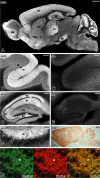Molecular dynamics of a presynaptic active zone protein studied in Munc13-1-enhanced yellow fluorescent protein knock-in mutant mice
- PMID: 17167095
- PMCID: PMC6674949
- DOI: 10.1523/JNEUROSCI.4330-06.2006
Molecular dynamics of a presynaptic active zone protein studied in Munc13-1-enhanced yellow fluorescent protein knock-in mutant mice
Abstract
GFP (green fluorescent protein) fusion proteins have revolutionized research on protein dynamics at synapses. However, corresponding analyses usually involve protein expression methods that override endogenous regulatory mechanisms, and therefore cause overexpression and temporal or spatial misexpression of exogenous fusion proteins, which may seriously compromise the physiological validity of such experiments. These problems can be circumvented by using knock-in mutagenesis of the endogenous genomic locus to tag the protein of interest with a fluorescent protein. We generated knock-in mice expressing a fusion protein of the presynaptic active zone protein Munc13-1 and enhanced yellow fluorescent protein (EYFP) from the Munc13-1 locus. Munc13-1-EYFP-containing nerve cells and synapses are functionally identical to those of wild-type mice. However, their presynaptic active zones are distinctly fluorescent and readily amenable for imaging. We demonstrated the usefulness of these mice by studying the molecular dynamics of Munc13-1-EYFP at individual presynaptic sites. Fluorescence recovery after photobleaching (FRAP) experiments revealed that Munc13-1-EYFP is rapidly and continuously lost from and incorporated into active zones (tau1 approximately 3 min; tau2 approximately 80 min). Munc13-1-EYFP steady-state levels and exchange kinetics were not affected by proteasome inhibitors or acute synaptic stimulation, but exchange kinetics were reduced by chronic suppression of spontaneous activity. These experiments, performed in a minimally perturbed system, provide evidence that presynaptic active zones of mammalian CNS synapses are highly dynamic structures. They demonstrate the usefulness of the knock-in approach in general and of Munc13-1-EYFP knock-in mice in particular for imaging synaptic protein dynamics.
Figures







References
-
- Adesnik H, Nicoll RA, England PM. Photoinactivation of native AMPA receptors reveals their real-time trafficking. Neuron. 2005;48:977–985. - PubMed
-
- Aravamudan B, Broadie K. Synaptic Drosophila UNC-13 is regulated by antagonistic G-protein pathways via a proteasome-dependent degradation mechanism. J Neurobiol. 2003;54:417–438. - PubMed
-
- Augustin I, Rosenmund C, Südhof TC, Brose N. Munc13-1 is essential for fusion competence of glutamatergic synaptic vesicles. Nature. 1999b;400:457–461. - PubMed
-
- Betz A, Okamoto M, Benseler F, Brose N. Direct interaction of the rat unc-13 homologue Munc13-1 with the N terminus of syntaxin. J Biol Chem. 1997;272:2520–2526. - PubMed
Publication types
MeSH terms
Substances
LinkOut - more resources
Full Text Sources
Other Literature Sources
Molecular Biology Databases
Miscellaneous
